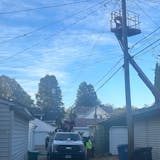There is another health disaster on the horizon. Just as with the current pandemic, there's plenty of evidence that a new wave is headed our way. What is it, and most important, will we be better prepared for it than we were for COVID-19?
Our food supply is now at risk. That's the fallout from the pandemic. Divide our food supply system into three parts: production, processing and distribution.
Production is at risk mostly because farmers can't get the workers they need to plant, tend and harvest their crops. This was a problem before the pandemic. It is more urgent than ever. Florida vegetable growers recently plowed under thousands of pounds of tomatoes and squash primarily because they did not have the workers to harvest them.
Processing is in jeopardy because of the way our facilities are designed and operated. Workers are frequently shoulder to shoulder. Infectious diseases like COVID-19 can spread rapidly in this environment. The Smithfield pork processing facility (one of the nation's largest) in Sioux Falls, S.D., is now closed indefinitely. The city is now a "hot spot" thanks to hundreds of cases from this single site. Plants in Iowa, Nebraska, Colorado and Pennsylvania are also now closed. The JBS plant in Worthington went from no cases to dozens in a few days and is now closing. Add Minnesota to the list.
Distribution is challenged because there is a developing mismatch between products and customers. Distribution divides into two major categories: food service and grocery. The former supplies about one-half of our food and goes to restaurants, institutions and other community food services. The latter delivers the other one-half, going to retail grocers, big and small. Food-service deliveries have almost evaporated. Grocers need everything they can get. Even if there's no interruption in production and processing (see above), there is still a big problem, literally. Food going to restaurants and food services cannot simply be diverted to grocery stores, unless families are willing start buying 50-pound bags of flour, vegetables by the crate and #10 cans of ketchup.
So, what can we do now to strengthen our food supply? Identify and implement changes that bring immediate results. "Immediate" is key. The system must be resilient enough to supply Minnesota and the nation if the pandemic persists, recedes slowly and/or returns full-on for round two. One, two or all three of these scenarios could be in our immediate future.
Eliminating worker shortages is central to maintaining crop/dairy production. One concrete step is passage of the Farm Workforce Modernization Act by the U.S. Senate. The U.S. House did so in December 2019 with bipartisan support. It is teed up in the Senate. This legislation gives unauthorized immigrant farmworkers a path to an ag work visa that is good for five years and renewable. It also streamlines the process that farmers use to bring workers to the United States. Its passage will be a huge "thank you" and green light to more than 1 million farmworkers who are more fearful than ever about their ability to live and work in the U.S.
To pandemic-proof processing facilities, managers could test and monitor all workers so no one enters their plants sick. The public officials should facilitate this by putting food processing workers at the top of the worker testing list. Plant managers could also reconfigure their production lines and common areas so there is more space between workers. Less production is light years better than none at all.

